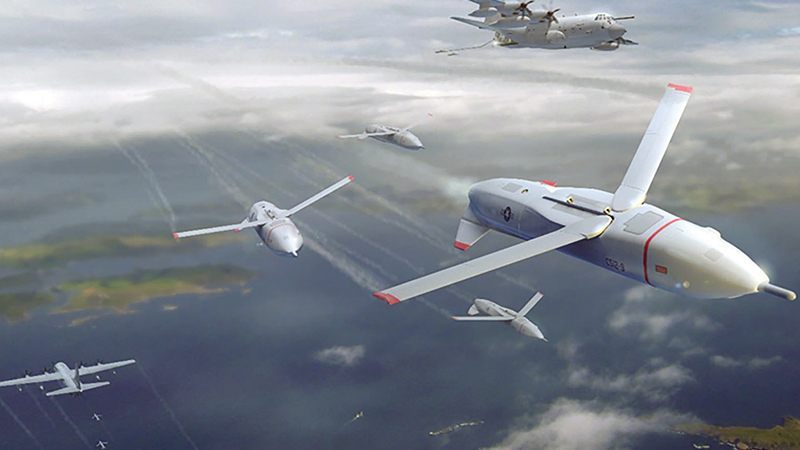Wanted: “Aircraft carrier in the sky”
By Keith Button|May 2017
It’s easy to imagine conventional military planes releasing swarms of drones. It’s a lot harder to imagine a C-130 recovering them in midair so they can be flown again. By next February, DARPA should have in its hands two competing preliminary designs for an apparatus to do just that.
Dynetics Inc. of Alabama and General Atomics Aeronautical Systems of California are working on competing designs under $21 million contracts awarded by DARPA earlier this year. The program is called Gremlins, and under it the contractors get to decide the kinds of drones that they will retrieve if the program proceeds to a demonstration phase two years from now. The biggest technical challenge will be controlling and lining up the drones just before they are picked up by the C-130s, which are typically flying at 370 to 560 kilometers per hour.
“The glory or the interest in these technology programs tends to focus on the innovative nature of the air vehicles,” says Mark Miller, the Gremlins program manager at Dynetics. “The DARPA-hard part, in our opinion, is in the recovery of an unmanned system aboard a manned aircraft,” he says. Typically, aircraft “drop bombs, and drop missiles — they don’t recover them in the air,” he notes dryly. The safety concerns of flying unmanned aircraft so close to manned aircraft, and not keeping what is normally considered the “safe distance” between the two, is amplified by the buffeting created by the wind flows around the cargo aircraft, says Tim Keeter, chief engineer at Dynetics.
The drones will be designed as “trucks” — capable of carrying either weapons or sensors. DARPA is allowing the contractors to choose a launch and recovery method from either outside or inside the larger manned aircraft.
Dynetics isn’t divulging its concept for how to do that; General Atomics said in 2016 that it was considering a mechanical arm that would move the planes in and out of the C-130’s cargo bay.
According to DARPA, the agency’s vision for the program is to show how groups of drones could be launched from many types of military aircraft, including bombers, transport planes, fighters and other unmanned airplanes. They would be picked up later by a C-130, returned to the ground and be ready for launch again in 24 hours. Disposable drones and decoys are a trend in the U.S. military, but DARPA says reusing such planes about 20 times each would save money compared to expendable operation.
In March 2016, Composite Engineering of California, Dynetics, General Atomics and Lockheed Martin won initial contracts for the Gremlins program to develop feasible ideas for launching and recovering unmanned aircraft with minimum modifications to the C-130s. Dynetics and General Atomics were chosen for the second phase. In a third phase, DARPA plans to choose one or perhaps both of the competitors to build a demonstration system for flight testing in 2019.
Related Topics
Aircraft Design“The DARPA-hard part, in our opinion, is in the recovery of an unmanned system aboard a manned aircraft.”
Mark Miller, the Gremlins program manager at Dynetics








